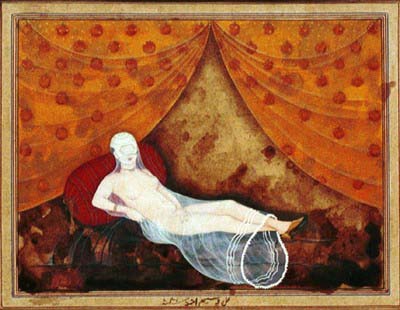 © Muhammed Imran Qureshi Contemporary miniature paintings from Pakistan Waseem Ahmad, Aisha Khalid, Muhammad Imran Qureshi, Saira Waseem, Hamra Abbas, Nusra Latif, Hasnat Mehmood, Reeta Saeed The artists in this show form a radical group of miniature painters who have all trained in the only department of miniature painting in the world: at the National College of Arts in Lahore, Pakistan. This group is radical because although their rigorous technique follows the traditional medium, their content is contemporary. They choose to replace the former themes, such as courtly propaganda under the Mughals or romantic legends in the Persian, Rajput or Pahari ateliers, with a critical commentary on actual social issues. Traditional themes serve the copying process vital to early stages of training, but whereas these are retained by the majority of students who follow the orthodox path, they are either rejected or critically recycled in the work of the "alternative" faction: the Group "X", made up of those artists who experiment at both formal and conceptual levels. Social problems of both local and global issues are subjected to acerbic illustration. Themes vary from the extremes such as fundamentalism, violence against women, political corruption, the western invasions of Afghanistan and Iraq, through the more conditioned or localised anxieties around feudalism, arranged marriages and the pressures of purdah, to the fall-out effects of American colonialisation such as gun-culture, drug addiction, McDonaldisation, sexist media and Bollywood machismo. Certain works operate through parody, using a pop art approach, but the more general tone is one of dark satire. References to tradition are made with deliberate irony whilst holding the greatest respect for the technique, without which, they believe, the miniature would become obsolete. The fetichisation of technique alone is often used in a nationalist discourse which condenses tradition to the reproduction of a homogeneous style. The danger of this lies in its denial of historical change. Miniature painting under its former lively patronage was in a process of constant hybridity, both using and surpassing earlier forms. Whereas reactionary revivalism is caught in the trap of the copy, mimicry can serve as a device of resistance, as the artists here reveal in their deliberate appropriations. The contemporary art scene in Pakistan is a lively one. Defying the lack of state subsidy, with support from the few experimental galleries and critics, artists challenge a growing audience with a wide variety of multi-media practices. Collaborative workshops are often set up, particularly in the wake of September 11th 2001, when the need was felt by artists for a shared reflection on the ensuing tensions. So why the apparent paradox of reverting to a traditional form? Recoveries of cultural forms are undertaken on the grounds of either reactionary or resistant discourse. With Partition and Independence in 1947, Pakistan's search for an "authentic" art form to image a national identity, re-appropriated the Mughal miniature style, since it was perceived as able "to establish continuity with a suitable past". (Hobsbawm 1983:1) The subversive nature of these contemporary miniatures questions the ideological motives behind such official revival strategies. All the 9 artists are under 35 years of age, five are women, a fact which marks the huge gender shift in the practice. Traditionally patriarchal, "trade secrets" were kept in the male side of the family and women were called on to grind the pigments. Today's practice in Pakistan is dominated by women artists, they are consciously exploiting the miniature format, often stereotyped as "feminine", as a vehicle for the personal and the political. (It is through the actions of women artists on both side of the contentious border between Pakistan and India, that exchanges and workshops are happening together) I believe that these paintings reveal how a traditional art form can become significant today through the artists' courage and political will to question and to transform. To show these works in Zurich is particularly opposite in relation to the superb collection of Miniature paintings in the Rietberg Museum. The scholarly studies of Drs. Goswamy and Fischer have pursued a specific research into the Pahari paintings from the Punjabi Hills, and it is with these workshops that Lahore has strong historical links. Since the young artists are only too aware of the former intercultural dialogues, it is to be hoped that an exchange may take place between the contemporary and the traditional practices through a discussion between the curators and the public during the run of the exhibiton. Curated by Virgina Whiles. October 10 - 26, 2003 Visits by appointment only. Please call Clare Goodwin 0041 76 409 84 43. K3 Project Space Maagareal Hardstrasse 219 8005 Zürich www.k3zh.ch |